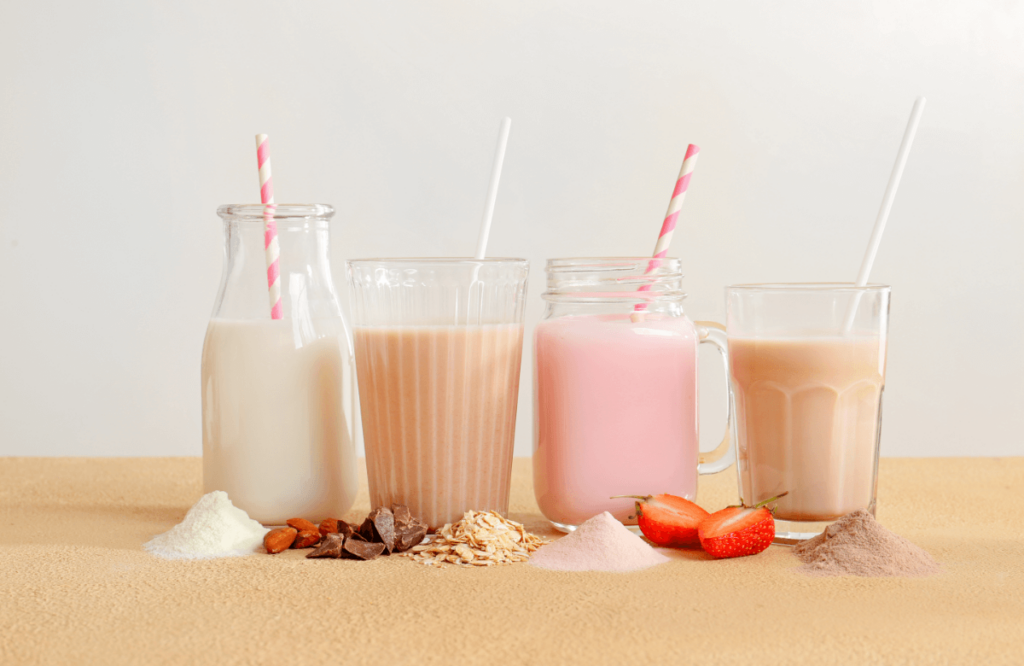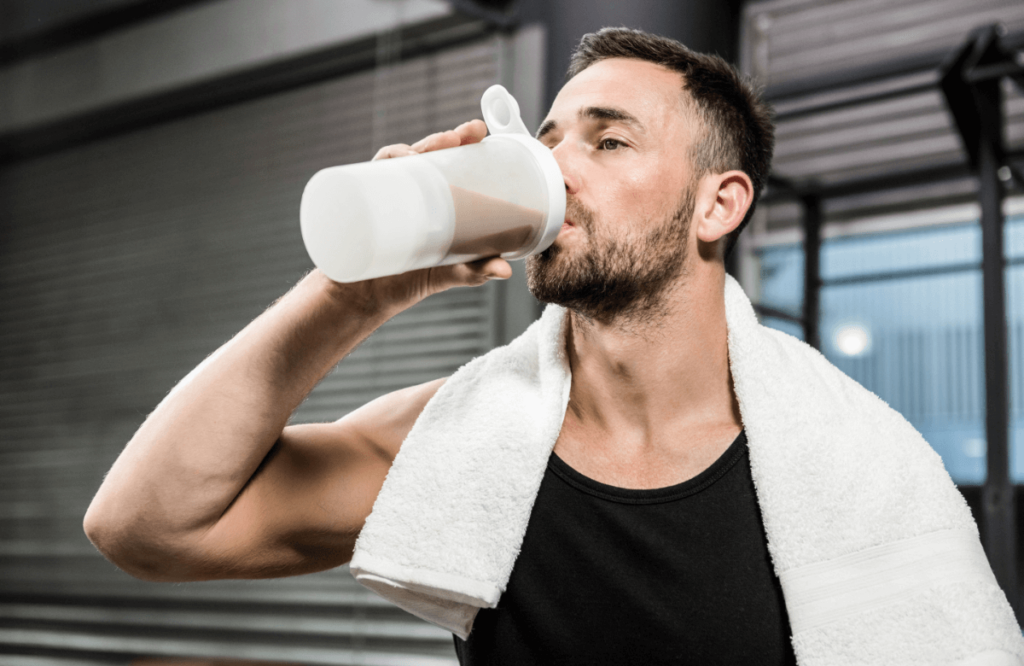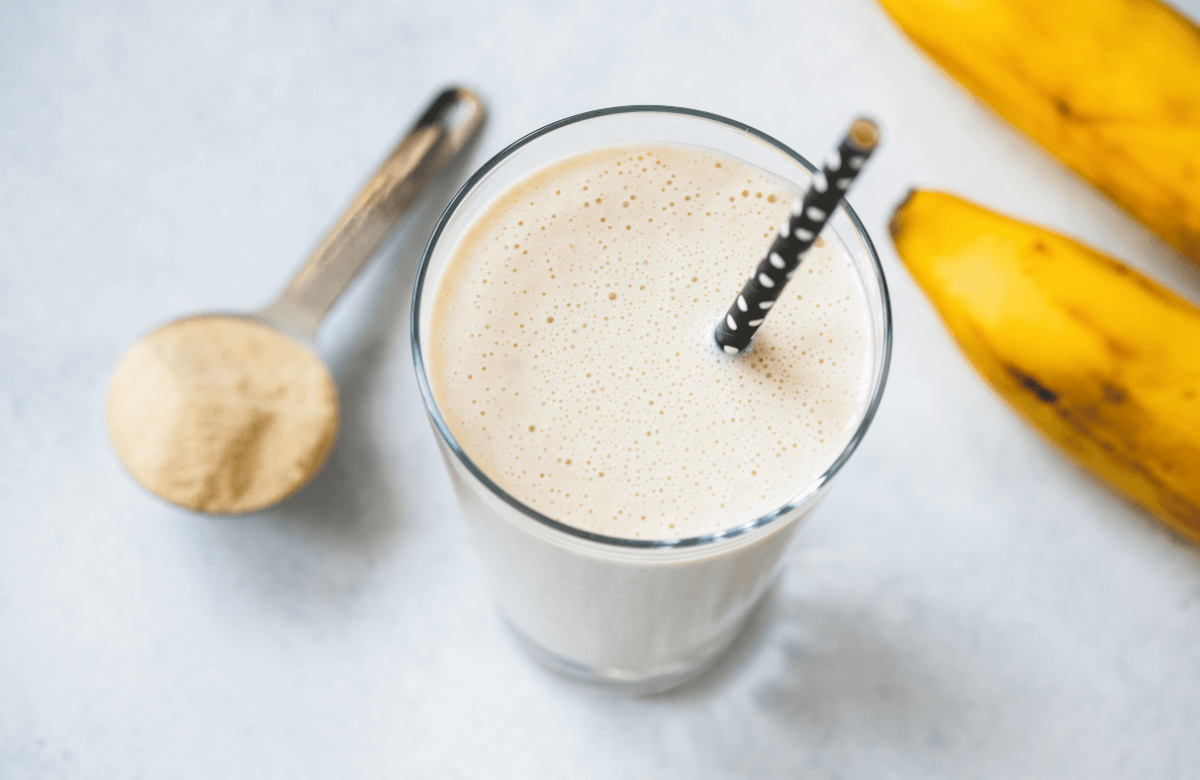Protein shakes are an extremely convenient and cost-effective way to get in the protein you need to aid recovery and build and maintain muscle mass. In this article, we are going to provide you with our ideas on how to make protein shakes taste better. Let’s get started.
Jump to:
- How to Make Protein Shakes Taste Better: Our 10 Tips
- 1. Make Your Own Protein Shakes
- 2. Avoid Poor-Quality Proteins
- 3. Choose the Right Type of Protein
- 4. Blend Your Vegetables, Fruits, and Greens First
- 5. Use Frozen Fruit
- 6. Add The Extras in The Middle
- 7. Don’t Be Afraid to Add More Liquid
- 8. Use a Good Blender
- 9. Not Overdo It With the Fruit
- 10. Don’t Add In Liquid Sweeteners
- What to Blend With Protein Shakes: 14 Best Protein Shake Ideas
- How to Make Protein Shakes Taste Better: FAQs
How to Make Protein Shakes Taste Better: Our 10 Tips
Here are 10 tips to make your shakes taste better:
1. Make Your Own Protein Shakes
You don’t have to follow a recipe exactly. Recipes can’t cover all your needs. We all are different. We have different tastes and needs. Choose the protein shake recipes that you like. But for example, if you are allergic to casein, replace this ingredient with water. And don’t be afraid to add new components to your recipe.
2. Avoid Poor-Quality Proteins
It’s pretty important to avoid extra processed foods. We’re looking to reduce artificial flavors and colors and added sugars. On top of that, a lot of delicious protein powders will also have added artificial sweeteners like sucralose, aspartame, and saccharin. We would recommend avoiding those as far as calorie-free sweeteners.
Prefer stevia and monk fruit. Those proteins are made from real sources and they don’t have nearly as many negative consequences.
Another claim that you’re going to see in a lot of protein powders is the added ingredients for enhanced performance like fitness supplements that are going to give you better recovery or better pump. That’s something we would recommend avoiding as well. All that is the marketer is trying to make it look better and be more of a marketable product by adding in all these extra supplements.
Protein should do the job that it’s supposed to do. Keep in mind the more stuff that gets added, the more opportunity for contaminants. So, we want to keep those ingredient lists as minimal as possible.
3. Choose the Right Type of Protein
Make sure that it tastes good and has a good texture and flavor. Let’s dive into the 4 main types of protein so that when you go and look at them in the grocery store or you’re shopping online, you understand what you’re looking at.
1. Whey Protein
This is the most commonly purchased and commonly understood form of protein powder. In order to make whey protein, you curdle milk, and that leftover liquid is the whey.
The good thing about whey protein is it’s rapidly absorbed by your body. Also, it’s a complete protein meaning that you get all essential amino acids from that one source.
Whey protein is also high in leucine which is one of those branched chain amino acids that is especially important. It is an essential amino acid and that means our body doesn’t produce it. We need to actually ingest it in order to have it. Among other things, it’s also very important for muscle recovery and growth.
Whey protein comes in a couple of different forms. There’s whey protein isolate and whey protein concentrate.
Whey Protein Concentrate
The concentrate is a good option and it’s less processed than the isolate. That’s going to contain about 80% protein. However, in that remaining 20%, you’re also getting lactose along with other carbs and fats. That means many people who suffer from lactose intolerance will likely have an issue with whey protein concentrate.
Whey Protein Isolate
Whey protein isolate is 90% protein so you do get a more isolated protein but you’re also getting a more processed protein. This type of protein is easier to digest. In fact, some companies even add in a lactase enzyme that helps break down that lactose in the protein to help it easier digest as well.
Typically you’re going to want about 80% of the product to be protein. If you’re using an animal-based protein powder, that typically isn’t as high of a percentage in plant-based proteins.
2. Casein Protein
Casein protein is the protein in the part of the milk that forms the curd. You may have heard casein referred to as a sustained-release protein and that’s because it’s a relatively slow-releasing protein which is not a bad thing.
It makes you feel fuller longer. It does contain less lactose. However, interestingly enough some people actually are allergic to casein itself.
If you have a cow milk allergy, those popular options are likely going to cause issues. Instead, we would recommend one of the next two options. Let’s talk about egg protein.
3. Egg Protein
Egg protein is generally made from egg whites which are super high in lean protein and are highly digestible. Egg protein is a great option for a protein powder unless you’re vegan or you’re choosing to just have non-animal-based foods. That brings us to our next option which is plant protein.
4. Plant Protein
Plant sources can be from peas, soybeans, rice, hemp, potatoes, and even pumpkin seeds. Typically plant proteins are good with their nutrient content but they do lack in their texture. Plant proteins tend to be a little bit more gritty and earthy and typically don’t dissolve as well as whey protein.
The added benefit of plant-based proteins is you get also more nutrients and especially you get more fiber as well. Fiber is essential for healthy eating weight loss, normal bowel movements, just feeling full, and overall having a healthy diet. So, both are perfectly good options for making protein shakes.

4. Blend Your Vegetables, Fruits, and Greens First
Whether that is banana, spinach, kale, mixed greens, collard greens, or celery, blend it first before you put it in your protein smoothie. You can either blend them with water or you can use milk or even juice. You need to make it like a juice consistency so there’s no more pulp or gritty texture it’s just literally juice.
5. Use Frozen Fruit
You can use fresh fruit but frozen fruit helps to make the smoothie cold and thick. You have the watery juice to dissolve protein powder so you need something to thicken it up. So, use frozen fruit for it.
6. Add The Extras in The Middle
Add quality protein powder, whatever type of seeds, extra sugar, vanilla extract, or anything else that you’d like to put in your smoothie in the middle. Don’t put it in at the very beginning or at the very end on top of everything. If you put it on the very top, it might not blend in well.
7. Don’t Be Afraid to Add More Liquid
Sometimes depending on what ingredients you’re using, the smoothie will get too thick. Don’t be afraid to add more liquid. That would help with the consistency and make it portable so that you could pour it out of the blender.
If you don’t want to add more milk, replace it with water. Remember it’s fine to add water into your protein smoothies, especially if you’re adding fruits like banana or mango. That’s going to give it that creamier texture and taste that you want without adding so much boxed, plant-based milk.
8. Use a Good Blender
This probably is one of the most important tips because oftentimes if your fruits or greens aren’t broken down, it is probably because you are not using a good blender. Good blenders can be expensive but you can get some good ones that aren’t expensive as well.
9. Not Overdo It With the Fruit
Adding too much fruit into your smoothie makes it way too sweet and sugary. It’s not necessary. You can use vegetables such as celery, cucumber, some greens, or ginger instead of fruits. They are going to add nutrients and texture to your smoothie without overdoing it with sugar.
10. Don’t Add In Liquid Sweeteners
If you’re using nice and ripe fruit, you don’t need extra sweeteners. You don’t need honey, maple syrup, sweetened yogurt, or sweetened almond milk. Also, look for protein powders that are low in sugar. Protein powder is expensive so make sure you’re buying a good one.

What to Blend With Protein Shakes: 14 Best Protein Shake Ideas
Here are ingredients that the top athletes are using to be the best.
1. Fruits
If you want your smoothie to be delicious, sweet, and easy to digest, make sure you’re using ripened fruit. For example, bananas. They are cheap and a great base for your smoothie.
A common way is to use frozen fruit. If you have fruit that’s about to get too ripe, peel and cut it up. Freeze it and then use it in your protein smoothie. Adding ice to smoothies makes it frosty and dilutes the flavor a ton. But by using frozen fruit, you’re still getting that frosty element without losing any flavor at all.
2. Liquid
The liquid is only there to thin the smoothie out of the consistency that you want. Think about what you want to add. Is it going to dilute the flavor? Is it going to add sweetness or make it creamy? That’s what you need to think about when choosing a liquid.
You can use milk or dairy-free milk like almond milk or coconut milk for protein shakes. There are also fruit juices like orange juice which is the most popular choice. You can add even filtered water because almost every ingredient of better-tasting protein shakes has too much sugar.
3. Greek Yogurt
Greek yogurt has antioxidants, antibiotics, and slow-releasing protein which helps fuel your muscles throughout the day. It also provides calcium which is needed for building and maintaining strong bones.
4. Chocolate Powder or Cocoa Powder
To boost the chocolate flavor of your shake, use a sugar-free chocolate powder. It is rich in theobromine and protects you from diseases such as diabetes, heart disease, and cancer.
5. A Raw Egg
One large raw adds 6 grams of extra high-quality protein to your shake. Also, it is a good source of important nutrients such as vitamin D which is important for immune function and bone health.
6. Healthy Fats and Fiber
These are two things that are going to make your smoothie filling and satiating. If you are hungry after drinking your protein shake, it’s because you’re not adding substance to your smoothie.
Protein is important, but fiber and healthy fats help keep you full. For example, use chia seed for fiber. For healthy fats, you can add coconut oil, peanut butter, or fresh avocado. They will also add some extra calories to your shake.
7. Flaxseed
Maybe you’ve never heard of this ingredient before. Adding one tablespoon of flaxseeds will make your protein shake packed in extra nutrients, omega-3 fatty acids, and fiber as well.
Flaxseed is a great source of thiamin, or a B1 vitamin, which plays a key role in cell function as well as metabolism. It’s also particularly high in copper, which helps in iron metabolism, immune health, and brain development. Flaxseed stabilizes blood sugar levels and lowers cholesterol levels as well.
8. Honey
You can also add honey if you want extra natural sweetness. It’s a natural sweetener and is used as an antioxidant, anti-inflammatory, and antibacterial agent. It will help you to treat coughs and improve blood sugar regulation.
9. Additional Protein
Protein is in so many foods. For example, pumpkin seeds are a great extra source of plant-based protein for adding to your protein shake. Spirulina powder has the highest amount of protein in plants. It also contains a lot of vitamins, minerals, antioxidants, and carotenoids as well.
10. Kale
Due to the amounts of vitamins A, K, and C, kale is a great ingredient for making delicious protein shakes. It also is rich in folate and a B vitamin that is important for brain health and development. Kale has omega-3 fatty acids, which are good for regulating your hormones and so much more.
11. Celery
Celery is rich in A, C, and K vitamins and minerals as well. It has a low glycemic index. Celery also reduces inflammation and cholesterol levels, boosts weight loss, lowers blood pressure, and so much more.
12. Carrots
It is another vegetable rich in minerals and vitamins. It’s also great for your hair and skin. Carrots are packed with fiber and beta-carotene, boost immunity, and improve brain health. They help with cardiovascular support and weight loss.
13. Hemp Seeds
Adding in one tablespoon of hemp seeds will make your shake rich in essential fatty acids. Hemp seeds are also a great source of minerals and vitamin E which is especially needed for women. They are rich in protein, help skin disorders, and reduce your risk of heart disease.
14. Citrus and Ginger
Add a little bit of ginger and juice of lime. That is going to boost your immune system, promote heart health, and manage diabetes.
Now that you know about ingredients, you can create your own protein smoothies specifically for what you need.

How to Make Protein Shakes Taste Better: FAQs
Why does my protein shake taste so bad?
Protein shakes can usually have bad tastes because of the type of protein powder used. The taste of protein shakes can vary depending on what extra ingredients and flavors are added. Generally, artificial sweeteners and low-quality ingredients can contribute to a chalky or bitter protein powder taste.
Is it OK to mix whey protein with milk?
You can definitely mix whey protein with milk if you are looking to build bulk muscle. That’s also going to give it that milky texture and sweet taste. It will add some amount of fats and carbohydrates to your tasty protein shakes as well.















